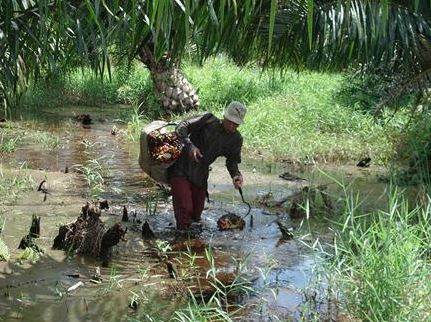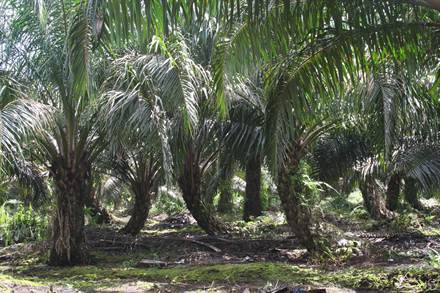
Bankers, what are the risks of your peatland investments?
The world’s increasing demand for palm oil and pulp wood for paper production attracts the private sector to invest more and more in these businesses in Indonesia and Malaysia. But are banks, the creditors of these businesses, aware of the risks of their investments in palm oil and pulp wood plantations when these are developed on peatlands?
Oil palm and pulp wood cultivation on peatlands used to be perceived as an attractive and lucrative option for many plantation developers in Southeast Asia. However, in recent years the media have been dominated by the shadow sides to such drainage-based plantations, being associated with peat fires, choking haze, climate change and land subsidence. As a result platforms such as the Roundtable for Sustainable Palm Oil (RSPO) and individual plantation companies (Wilmar, GAR) buyers (Unilever, Kellogg’s, Nestlé) have recently committed to no peatland conversion.
It is time for the financial sector to come on board and become actively involved in the sustainable development of peatlands. The Indonesian Ministry of Environment (MoE) and Wetlands International therefore brought together fifty participants from banks, government and the Indonesian palm oil association (GAPKI) on 3 June 2014 in Jakarta to discuss the uncertainties related to large-scale clearing projects in peatland areas. The seminar (featured in the Jakarta Post and Hukumonline.com) called upon banks to be prudent prior to granting loans or financing investments in plantations, particularly to plantation projects in peatlands.
Uncertain business
One of the major risks to plantations on peat are the dramatic fires which spiked again this year in Sumatra, largely on drained peat soils. The fires are impacting millions of people in Indonesia, Malaysia and Singapore due to the haze, causing major economic damages and public health impacts. The peat fires are also the main cause of immense GHG emissions (see AR5 WGIII report, IPCC 2014)[1].
According to Global Forest Watch roughly half of the fires are burning on land managed by pulpwood, palm oil, and logging companies, and some of the largest fires are on fully developed plantations. But most fires are caused by smallholder developments. Efforts to eliminate fire in development and management practices is costly as it demands access to heavy equipment for land clearance and major investments in water management structures.
Moreover, fire control often fails, partly because surrounding areas impacted by the drainage of plantations (up to several kilometres surrounding the plantation) may fall outside of the management remits or capacity of the plantation owner. For Indonesia the peat fires are also a key concern for achieving its GHG emissions reduction target (26% by 2020). Half of Indonesia’s emissions are resulting from current peatland development and management practices. These issues provide sufficient reason to prohibit the expansion of plantations on peat.

A relatively under-recognised issue, and therefore highlighted in the Jakarta meeting is theissue of subsidence of the peatland surface, which results from the oxidation of peat following drainage required for plantations. In the tropics this process of subsidence is very fast due to high temperatures and inevitably leads to severe floods when the peat surface comes close to river or sea levels. This will already happen within the next 25 to 50 years in many of Indonesia’s lowland peatlands and may thus result in the loss of millions of hectares of arable land[2].
In his presentation, Nyoman Suryadiputra, Director of Wetlands International Indonesia, showed examples of palm oil plantations that are already flooded for a part of the year. The issue of soil subsidence would justify consideration of a phasing out of existing plantations on peat, well before flood risks in these areas will become untenable.
Mr. Suryadiputra also presented pictures of leaning oil palms. The peat in which the oil palms are rooted does not give sufficient physical support when the palm is growing. The palm trees are apt to fall over and lean, resulting in reduced productivity[3].

Bad credits
It became clear that further awareness needs to be built among bankers on the impacts and related economic risks of the plantation industries. The Indonesian bank Mandiri illustrated that they have disbursed credits for plantation development to oil palm companies worth 44.3 trillion rupiahs (3.7 million USD), of which 35% have their plantations in peatlands. However, only 0.13% of the credits have been categorised as bad credits meaning that the company could not pay back the loan. Therefore investing in palm oil plantations seems still profitable for banks and it is a challenge for environmental groups to influence the banks’ credit policies on the basis of longer term impacts. Reconsideration of such investments will require a broader economic perspective.
Fortunately, Indonesian banks such as BNI, Mandiri and BNP Paribas have started to put more attention to the sustainability issues of their investments. Also Otoritas Jasa Keuangan (OJK/The financial services authority) – part of Bank of Indonesia (BI) has shown their interest to include peatlands in the risk assessment prior to credit disbursement. A concrete first step is that OJK and the Ministry of Environment have signed a Memorandum of Understanding on sustainable finance development in Indonesia including compliance with existing environment regulations. This partnership can be used as a platform to engage NGOs with the private sector and government to provide technical assistance on identifying the risks related to plantations in peatlands.
Solutions
In the meeting, Wetlands International emphasised that solutions to mitigate impacts on peatlands should be sought. Firstly, no (new) drainage-based plantations should be developed on peat. For existing plantations, we recommend using intermediate best management practices, restoration of peat swamp forests and alternative development like paludiculture: agriculture and forestry on rewetted peatlands using commercially interesting indigenous species adapted to the wet peatland environment. Examples are Illipe nut (an oil producing crop), Jelutung (a latex producing crop) and rattans.
It will be important to enhance the awareness and capacity of investors and the financial sector to incorporate the issues related to plantations on peatlands in their risk assessments to ensure sustainable land use planning.
Wetlands International works with Deltares in better quantifying the peatland subsidence problem in SE Asia. These insights in peatland drainage impacts and subsidence rates are largely taken from Hooijer et al. (2010) and Hooijer et al. (2012).
This workshop was supported by Norad.
[1] Lim, K. et al. RSPO Manual on Best Management Practices (BMPs) for Existing Oil Palm Cultivation on Peat. RSPIO, Kuala Lumpur, 2012
[2] Hooijer et al. Subsidence and carbon loss in drained tropical peatlands. Biogeosciences, 9, 1053–1071, 2012
[3] IPCC Working Group III, Chapter 11 ‘Agriculture, Forestry and Other Land Use (AFOLU), April 2014.
